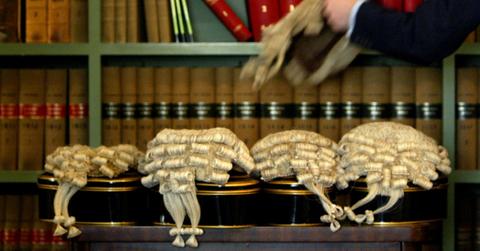British Lawyers Wear Wigs for a Pretty Noble Reason
Published Aug. 24 2021, 9:02 a.m. ET

Some traditions have been practiced for so long that people eventually forget why they're doing them. Like saying "bless you" after a person sneezes, which was reportedly popularized by Pope Gregory I, who believed that humans were susceptible to death whilst forcibly evacuating air from their nostrils. The "bless you" protected them from an otherwise gnarly death.
That's just one of many persistent traditions, but what about others? For example, why do British lawyers wear wigs?
Seriously, why do British lawyers wear wigs?
How weird and hilarious was it when you were first skimming through your social studies book as a kid and realized that George Washington wasn't the only OG U.S. politician to rock that ridiculous hairstyle? And how much more bizarre was it to discover that British legal workers today carry on the tradition of wearing a white wig that looks more in place on a caricature of a judge in Mr. Toad's Wild Ride than in a modern-day courtroom?

According to How Stuff Works, the entire purpose of a lawyer wearing a wig is to reinforce the idea of anonymity; it's basically the same concept as "the law is blind." The law should be "blind" to race, ethnicity, social standing, net worth, Instagram followers, or your political affiliations.
The outlet compares the wig to a uniform: "Like many uniforms, wigs are an emblem of anonymity, an attempt to distance the wearer from personal involvement and a way to visually draw on the supremacy of the law, says Newton. Wigs are so much a part of British criminal courts that if a barrister doesn't wear a wig, it's seen as an insult to the court."
Judges and barristers wear wigs too, however, they're different than the ones that lawyers sport. Barrister wigs have a little more razzle-dazzle to them, and the wigs that judges rock make them look more like a final boss than anyone else in the courtroom.
Why did people start wearing wigs in the first place? Because humans are disgusting.
Historically speaking, there are some cultures that either disliked taking baths or didn't develop hygienic means of living for one reason or another. By modern standards, life in 16th and 17th century Britain was, well, kind of revolting.
That's because folks didn't really bathe all that often and instead thought it would be better to just wipe oneself with a white linen cloth. No one really seemed to care that much about hygiene as they were probably just wondering where their next meal was coming from, so naturally, lice became a huge problem.
Instead of, you know, altering society to find a way to lead cleaner, healthier lives, they decided to just put on wigs instead, and it kind of worked. Instead of attacking people's actual hair, the lice would infest the wigs instead, so folks were either free to shave their own scalps or cover their natural hair with a cloth while a bunch of bugs gathered on their wigs instead.
It must've helped that the wigs were made out of white horsehair, with cheaper wigs fashioned out of a shaved goat's follicles instead. It didn't take long for wigs to become a status symbol, and if that seems weird to you, well, just remember that sneakers transformed from being no-nonsense athletic wear to a multi-billion dollar industry and there are people who dedicate their entire lives to sneaker reselling.